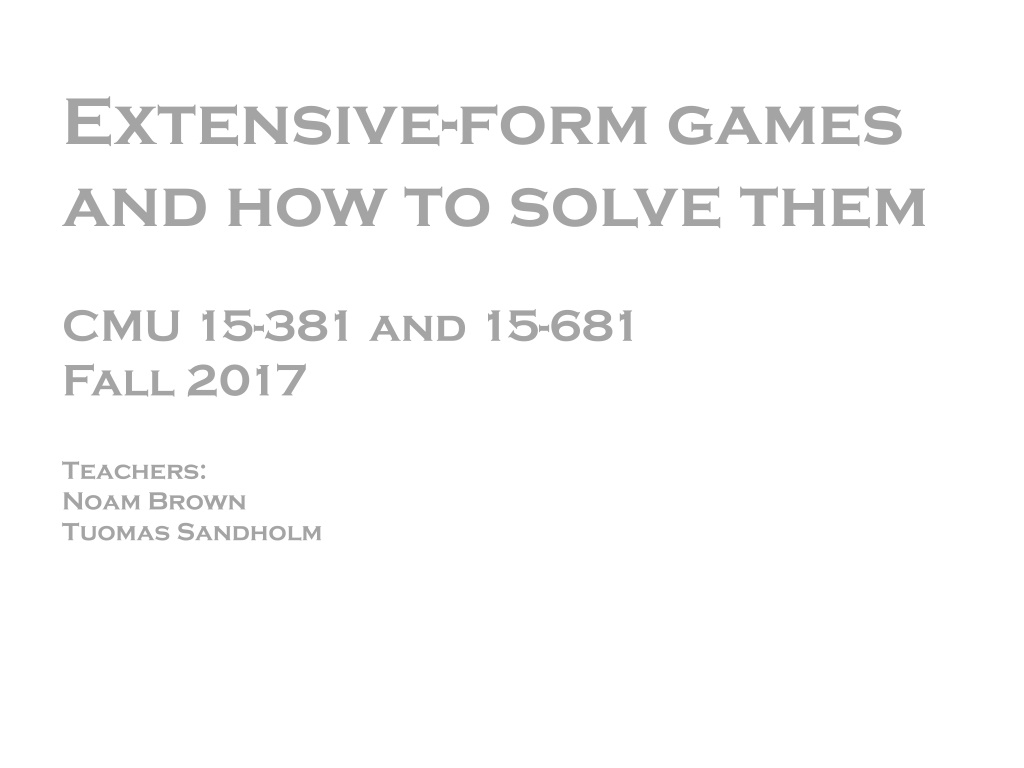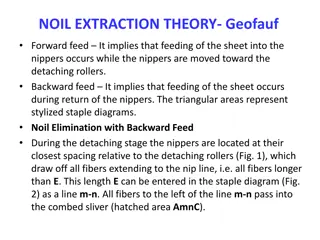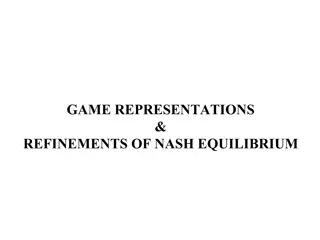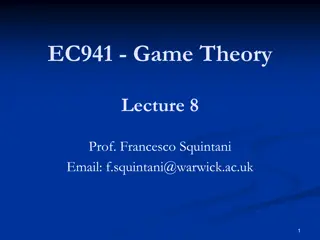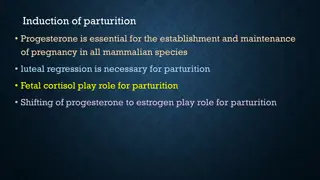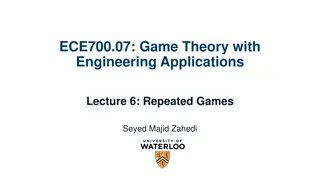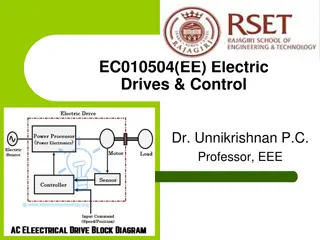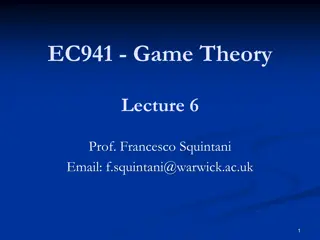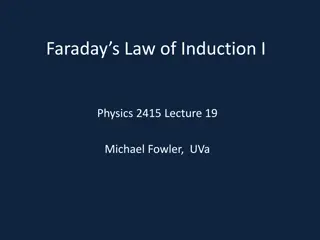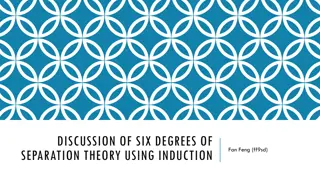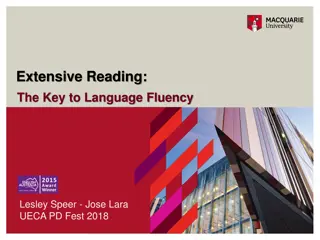Understanding Extensive-Form Games and Backward Induction
Explore the concepts of extensive-form games, two-player zero-sum games, and backward induction in game theory. Discover how players strategize, maximize utility, and navigate decision trees to reach optimal outcomes. Dive into the fundamentals of game theory assumptions and the strategies used to solve complex game scenarios.
Download Presentation

Please find below an Image/Link to download the presentation.
The content on the website is provided AS IS for your information and personal use only. It may not be sold, licensed, or shared on other websites without obtaining consent from the author. Download presentation by click this link. If you encounter any issues during the download, it is possible that the publisher has removed the file from their server.
E N D
Presentation Transcript
Extensive-form games and how to solve them CMU 15-381 and 15-681 Fall 2017 Teachers: Noam Brown Tuomas Sandholm
What are Games? Requirements for a game: At least 2 players Actions available for each player Payoffs to each player for those actions Examples?
What is Game Theory? Assumptions in Game Theory: 1) All players want to maximize their utility 2) All players are rational 3) It is common knowledge that all players are rational
Two-Player Zero-Sum Games For now, we will focus on two-player zero-sum games Only two players Whatever one player wins, the other player loses Common in recreational games (rock-paper-scissors, chess, Go, poker) Player 2 Rock Paper Scissors Rock 0, 0 -1, 1 1, -1 Player 1 Paper 1, -1 0, 0 -1, 1 Scissors -1, 1 1, -1 0, 0
Extensive-Form Games P1 Moves are done sequentially Although information sets , discussed later, enable modeling simultaneous moves too P2 P2 -4,4 -2,2 -3,3 There can be an extra player called chance (aka. nature) that plays stochastically, not strategically P1 1,-1 0,0 Game forms a tree Rewards are shown for P1, then P2
Backward Induction P1 Start at the bottom of the tree and solve assuming we reached that point P2 P2 Replace the decision point with the value of the decision -4,4 -2,2 -3,3 P1 Move up, and repeat 1,-1 0,0
Backward Induction P1 Start at the bottom of the tree and solve assuming we reached that point P2 P2 Replace the decision point with the value of the decision -4,4 -2,2 -3,3 P1 Move up, and repeat 1,-1 0,0
Backward Induction P1 Start at the bottom of the tree and solve assuming we reached that point P2 P2 Replace the decision point with the value of the decision 2,4 -2,2 5,3 1,-1 Move up, and repeat
Backward Induction P1 Start at the bottom of the tree and solve assuming we reached that point P2 P2 Replace the decision point with the value of the decision 2,4 -2,2 5,3 1,-1 Move up, and repeat
Backward Induction P1 Start at the bottom of the tree and solve assuming we reached that point P2 -2,2 Replace the decision point with the value of the decision -4,4 -3,3 Move up, and repeat
Backward Induction P1 Start at the bottom of the tree and solve assuming we reached that point -4,4 -2,2 Replace the decision point with the value of the decision Move up, and repeat
Backward Induction P1 Start at the bottom of the tree and solve assuming we reached that point P2 P2 Replace the decision point with the value of the decision -4,4 -2,2 -3,3 P1 Move up, and repeat 1,-1 0,0
Converting to Normal Form P1 Every extensive-form game can be converted to a normal-form game A B P2 P2 ? L R Must define strategy for every situation -2,2 0,0 -1,1 -3,3 Problem: Exponential in the size of the game L / L / ? R / R / ? A -2,2 -2,2 -3,3 -3,3 B 0,0 -1,1 0,0 -1,1
Solving Perfect-Information Games Checkers solved can always draw [Schaeffer et al. "Checkers is solved." Science (2007)] At about 1020 states, checkers is the largest game ever solved. Chess has about 1040. Go has about 10170. 14
Imperfect-information Games C What about games like poker? P1 P1 Backward induction doesn t work in imperfect- information games! -0.5 0.5 P2 P2 An information set is the set of all possible states (nodes in the game tree) that the player may be in, given the information available to him. 1 -1 -1 1 A strategy must be identical for all nodes in an information set. 15
Half-Street Kuhn Poker 3 cards: K, Q, and J. Highest card wins Two players are dealt one of the cards Both players ante 1 chip P1 may bet or check If P1 checks, the higher card wins 1 chip If P1 bets, P2 may call or fold - If P2 folds, P1 wins 1 chip - If P2 calls, the higher card wins 2 chips P1 1 P2 2 1 Poll: What should P1 do with a Queen? 1. Always bet 2. Sometimes bet, sometimes check 3. Always check 4. No idea 16
Imperfect-information Games C P1 P1 P1 P1 P1 P1 1 -1 1 1 -1 -1 P2 P2 P2 P2 P2 P2 2 2 1 1 1 -2 1 1 2 1 -2 -2 Try iterative removal of dominated strategies! 17
Imperfect-information Games C P1 P1 P1 P1 P1 P1 1 -1 -1 -1 P2 P2 P2 P2 P2 P2 2 1 -2 1 1 1 -2 -2 18
Imperfect-information Games C P1 P1 P1 P1 P1 P1 1 -1 -1 -1 P2 P2 P2 P2 2 -2 1 1 1 -2 19
Imperfect-information Games Two questions remain: How often should P1 bet with a Jack (bluff)? How often should P2 call with a Queen when P1 bets? Call with Q Fold with Q Bet with J Check with J
Imperfect-information Games Remaining game solved by making opponent indifferent. Let ? = ?(???|????) and ? = ?(????|?????) ?+1 2 1 = 2 ?+1 2( +1 ? 1 3 1 3 1 = 2 2 => ? = 1 ?+1) => ? = ? 21
Solving two-player zero-sum extensive-form games
AlphaGo AlphaGo techniques extend, in principle, to other perfect-information games
Example Game: Coin Toss P1 Information Set P1 Information Set C P1 P1 P2 Information Set P2 P2 -1 1 -1 1
Imperfect-Information Games: Coin Toss C Imperfect-Information Subgame P1 P1 P2 P2 -1 1 -1 1
Imperfect-Information Games: Coin Toss C P1 P1 P2 P2 -1 1 -1 1
Imperfect-Information Games: Coin Toss Heads EV = 0.5 Tails EV = 1.0 Average = 0.75 C P1 P1 P2 P2 -1 1 -1 1
Imperfect-Information Games: Coin Toss C P1 P1 P2 P2 -1 1 -1 1
Imperfect-Information Games: Coin Toss Heads EV = 1.0 Tails EV = -0.5 Average = 0.25 C P1 P1 P2 P2 -1 1 -1 1
Imperfect-Information Games: Coin Toss C P1 P1 P2 P2 -1 1 -1 1
Imperfect-Information Games: Coin Toss Heads EV = 0.5 Tails EV = -0.5 Average = 0.0 C P1 P1 P2 P2 -1 1 -1 1
Imperfect-Information Games: Coin Toss C P1 P1 P2 P2 -1 1 -1 1
Imperfect-Information Games: Coin Toss C P1 P1 P2 P2 -1 1 -1 1
Imperfect-Information Games: Coin Toss C P1 P1 P2 P2 -1 1 -1 1
Increasing scalability: Abstraction Idea: Create smaller game that is similar to big game Run equilibrium-finding algorithm on smaller game Map computed equilibrium to a strategy profile in big game
Abstraction[Gilpin & Sandholm EC-06, J. of the ACM 2007] Original game Abstracted game Automated abstraction Compact representation 10161 Equilibrium-finding algorithm Reverse mapping ~equilibrium -equilibrium Foreshadowed by Shi & Littman 01, Billings et al. IJCAI-03
Lossless abstraction C C 0.5 0.5 1 P1 P1 P1 P2 P2 P2 P2 P2 P2 10 10 0 0 0 0 10 10 10 0 0 10
Lossy abstraction C C 0.5 0.5 1 P1 P1 P1 P2 P2 P2 P2 P2 P2 8 10 0 0 0 0 10 10 9 0 0 10
-Nash equilibrium Standard Nash equilibrium: Each player has no incentive to deviate In other words: No agent can gain utility by switching to another strategy -Nash equilibrium: Each player has only incentive to deviate In other words: No agent can gain more than utility by switching to another strategy
Increasing scalability: Sparse algorithms We can solve games exactly using a linear program, but this requires ?(?2) memory where ? is the size of the game Idea: design algorithms that trade time/quality for memory Accept that algorithm outputs approximately correct answer: -Nash equilibrium (different from error from abstraction) Ideally: goes to 0 as algorithm runtime goes to infinity Memory usage is linear in the size of the game
Plan for next part of the presentation We will introduce counterfactual regret minimization (CFR)-based equilibrium finding in two-player zero-sum games Most common algorithm Relatively easy to understand and implement We start from first principles and proceed step by step to the most advanced algorithms in this family Used to be best in practice, but now there is a gradient-based algorithm that is better in practice also [Kroer et al. EC-17] But that is much more difficult to understand
